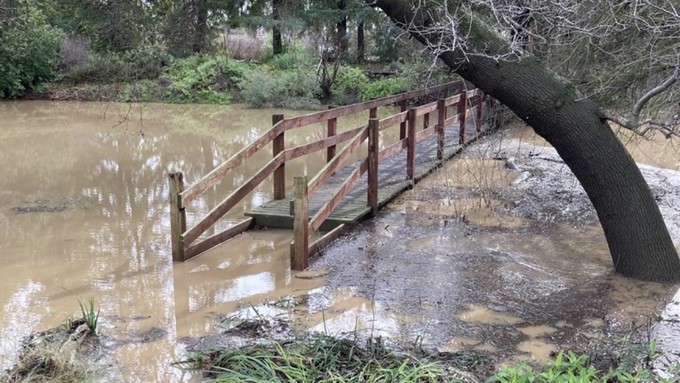
CNPS Garden Ambassador opens property for self-guided tours

This month is a great time to see how a native garden comes alive after the rains -- and floods. The bridges in Patricia Carpenter's garden were completely covered with water for a while, she says. Photo courtesy Patricia Carpenter
There is life in the garden in winter! And native plants are especially interesting, as anyone visiting Patricia Carpenter’s Yolo County garden on Sunday, Jan. 29, will be able to discover.
Carpenter, a California Native Plant Society Garden Ambassador, opens her property that day for her Seasonal Winter Ramble. Described as a “1-acre wild escape on the slough,” the garden is located west of Davis. Expect to see winter growth, wildlife, birds, fungi and emerging wildflowers, as well as the form and color of trees without their leaves.
The garden, west of Pierce Ranch Road south of Russell Boulevard, will be open from 11 a.m. to 3 p.m., rain or shine, for self-guided tours; start any time during those hours. Maps will be available for use on site. Admission is free but registration is required; find the form here. Specific directions to the site will be available to registrants.
Carpenter herself will offer an optional short orientation and Q&A session at noon, repeated at 2 p.m. (Meet near the check-in table.) She began planting the site in 2005, and it now features about 400 varieties of California natives. Visit her Garden Ambassador profile on the CNPS website to read more about the garden, including a plant list. Carpenter’s non-native garden also will be open to view Jan. 29, and the Miridae Mobile Plant Nursery will be on site for sales during the event.
Visitors to the garden are advised to wear sturdy shoes; bringing a lunch or snack is welcome. A composting toilet is available. Masks are optional. Please do not bring dogs.
Questions? Email both Carpenter, pcarpenter.flower@gmail.com, and Maya Argaman, margaman@cnps.org with "Garden Ramble" in the subject line.
Comments
0 comments have been posted.Sacramento Digs Gardening to your inbox.
Food in My Back Yard Series
May 6: Maintain soil moisture with mulch for garden success
April 29: What's (already) wrong with my tomato plants?
April 22: Should you stock up on fertilizer? (Yes!)
April 15: Grow culinary herbs in containers
April 8: When to plant summer vegetables
April 1: Don't be fooled by these garden myths
March 25: Fertilizer tips: How to 'feed' your vegetables for healthy growth
March 18: Time to give vegetable seedlings some more space
March 11: Ways to win the fight against weeds
March 4: Potatoes from the garden
Feb. 25: Plant a fruit tree now -- for later
Feb. 18: How to squeeze more food into less space
Feb. 11: When to plant? Consider staggering your transplants
Feb. 4: Starting in seed starting
Sites We Like
Garden Checklist for week of May 11
Make the most of the lower temperatures early in the week. We’ll be back in the 80s by Thursday.
* Plant, plant, plant! It’s prime planting season in the Sacramento area. Time to set out those tomato transplants along with peppers and eggplants. Pinch off any flowers on new transplants to make them concentrate on establishing roots instead of setting premature fruit.
* Direct-seed melons, cucumbers, summer squash, corn, radishes, pumpkins and annual herbs such as basil.
* Harvest cabbage, lettuce, peas and green onions.
* In the flower garden, direct-seed sunflowers, cosmos, salvia, zinnias, marigolds, celosia and asters. (You also can transplant seedlings for many of the same flowers.)
* Plant dahlia tubers.
* Transplant petunias, marigolds and perennial flowers such as astilbe, columbine, coneflowers, coreopsis, dahlias, rudbeckia and verbena.
* Keep an eye out for slugs, snails, earwigs and aphids that want to dine on tender new growth.
* Feed summer bloomers with a balanced fertilizer.
* For continued bloom, cut off spent flowers on roses as well as other flowering plants.
* Add mulch to the garden to maintain moisture. Mulch also cuts down on weeds. But don’t let it mound around the stems or trunks of trees or shrubs. Leave about a 6-inch-to-1-foot circle to avoid crown rot or other problems.
* Remember to weed! Pull those nasties before they set seed.
* Water early in the day and keep seedlings evenly moist.